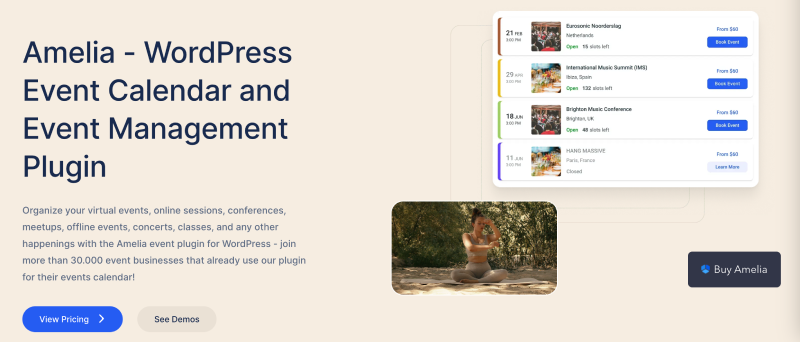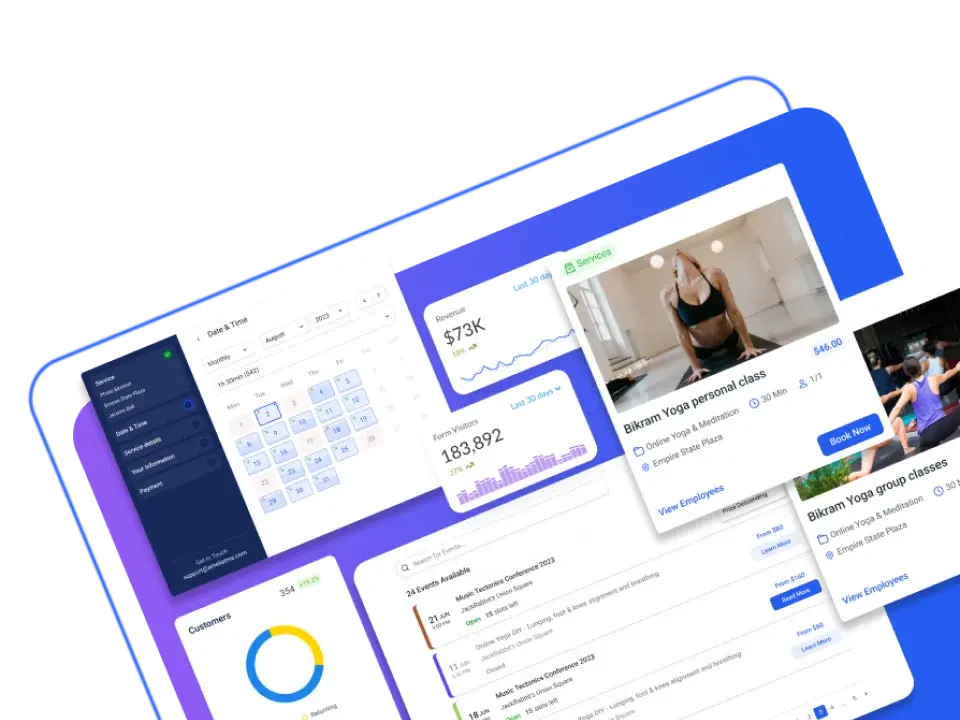Event planning is a dynamic process that unfolds in distinct stages, each playing a role in the overall success of an event. Understanding and navigating these stages of event planning is crucial for organizers who want to deliver memorable experiences.
Let’s explore how to make the most out of each event planning stage, starting with the foundational step – defining the purpose and scope of the event.
#1 Stage of Event Planning – Purpose and Scope of the Event
At the outset, the event’s purpose and scope lay the groundwork for the entire planning process.
This initial event planning stage involves ideation sessions to clarify objectives, identify target audiences, and outline the event’s overarching goals. Whether it’s a corporate conference, wedding celebration, or community gathering, defining these fundamental aspects shapes the subsequent stages of event planning.
Here’s a guide on how to define the purpose and scope of an event:
Clarify organizational goals
Begin by understanding the broader goals and objectives of the organization or stakeholders hosting the event. Align the event’s purpose with these overarching goals to ensure cohesion.
Questions you should ask yourself at this stage of event planning are:
What are the primary goals and objectives of the event?
What specific outcomes do we want to achieve?
You should also identify and engage with key stakeholders, including sponsors, partners, and decision-makers. It’s important to understand their expectations and desired outcomes for the event.
Determine the type of event
Clearly define the type of event you are planning. Is it a conference, seminar, product launch, fundraiser, or social gathering? The nature of the event will influence its purpose and scope. Here are some questions that will guide you through this stage of event planning:
What type of event are we planning (e.g., conference, workshop, networking event)?
Should the event have a specific theme or format?
Once you’re done, it’s time to define the primary goal or objective of the event. This could be to launch a new product, educate attendees, raise funds for a cause, or foster networking among participants.
Identify target audience
It’s crucial to determine the target audience for the event. We also advise you to create a whole target avatar because understanding the demographics, interests, and needs of the attendees will help shape the purpose and content of the event.
One of the most important questions you should ask yourself is:
Who is the target audience for the event?
What are the demographics, interests, and needs of the attendees?
Focus on attendee experience
Envision the experience you want attendees to have. Whether it’s an educational, entertaining, or networking-focused event, understanding the desired experience helps define the event’s purpose.
What kind of experience do we want attendees to have?
How can we make the event memorable for participants?
How can we encourage attendee engagement and participation?
What interactive elements can be incorporated into the event?
Set measurable objectives
Establish measurable objectives that align with the event’s purpose. These objectives should be specific, measurable, achievable, relevant, and time-bound (SMART).
For example, target a certain number of attendees or achieve a specific fundraising goal.
Define event theme and message
To strengthen your goals and attendee experience, it’s important to develop a central theme or message that encapsulates the purpose of the event. This theme will guide the overall branding, content, and communication strategies.
Should the event have a specific theme or branding?
How can the theme align with the event’s purpose and resonate with the audience?
Document purpose and scope
Compile all the information gathered into a comprehensive document that clearly outlines the purpose, goals, objectives, and scope of the event. Share this document with the planning team and stakeholders for alignment.
#2 Stage of Event Planning – Logistics
Once you establish the purpose and scope, the focus shifts to meticulous planning and logistics.
This event planning stage involves creating a comprehensive event plan, detailing timelines, budgets, and resource requirements. Navigating through the details of securing permits, choosing vendors, and coordinating logistics lays a solid foundation for the upcoming event.
Here are some strategies to ensure smooth planning and logistics execution:
Develop a detailed event plan
- Create a comprehensive event plan that outlines all tasks and responsibilities.
- Include timelines, deadlines, and dependencies to provide a clear roadmap for the planning process.
Budgeting and resource allocation
Develop a realistic budget that covers all aspects of the event, including venue, catering, technology, marketing, and miscellaneous expenses. If you don’t have all the resources at your disposal, allocate resources based on priority and importance to the event’s overall success.
Remember, the available budget will influence the scale, features, and logistics of the event, helping to define its scope. You need answers to these questions to make this event planning stage successful:
What is the budget for the event?
How can we maximize value within budget constraints?
Coordinating vendors and suppliers
At this point, you should identify and secure reliable vendors and suppliers for catering, audio-visual equipment, decorations, etc.
It’s important to clearly communicate expectations, deadlines, and specifications to vendors.
Obtain necessary permits and permissions
- Research and obtain all required permits and permissions for the event.
- Ensure compliance with local regulations and laws related to events.
Develop a contingency plan
With all these things in place, you can already anticipate potential challenges and develop a contingency plan to address unforeseen issues.
The most important things to consider are backup options for critical elements like venues, speakers, and equipment.
What potential challenges could arise, and how can we address them?
What should be included in our contingency plan?
Technology integration for registrations
Why would you do it yourself when there are perfectly capable software solutions that can help you?
Leverage technology for efficient planning and execution, including event management solutions, registration systems, and communication tools.

Organizing a successful event requires a reliable and efficient event management solution, and Amelia stands out as the go-to plugin for WordPress. With over 30,000 event businesses already benefiting from its features, Amelia is a top-tier event calendar and management plugin. It simplifies the organization of virtual and offline events, conferences, meetups, concerts, and more. What sets Amelia apart is its responsive and customizable design, catering to various event types such as conferences, yoga sessions, training, and even dog shows.
Why choose Amelia?
Amelia’s flexibility shines through its diverse features, including:
- The ability to set up recurring events,
- Create customizable booking forms, and
- Facilitate deposit payments for on-site events.
The plugin supports multilingual events, enabling organizers to offer a booking experience in different languages. Event planners can easily implement dynamic ticketing, setting different prices based on attendee profiles or purchase dates.
The plugin also provides convenient filtering and sorting options, making navigation straightforward for both organizers and attendees.
One of Amelia’s standout features is its seamless integration with Google Calendar and Outlook, ensuring hosts and attendees stay informed about upcoming events.
Amelia’s commitment to user-friendly interfaces, automated customer notifications, custom fields, and a simple admin panel makes it a valuable asset for event organizers. The plugin’s efficiency is evident in its ability to streamline the event management process, from creating and tracking tickets to managing cancellations and reminders.
Amelia not only modernizes the event booking experience but also enhances interactions between customers and organizers.
It reduces administrative burdens, allowing event managers to focus on organizing memorable events. With its constant updates, integration capabilities, and support for virtual sessions, Amelia is the comprehensive solution for event agencies and hosts looking to take their events to the next level.
It’s important to test all technology solutions in advance to identify and address any issues.
That’s why we’re providing you with Demos you can test out and see whether Amelia satisfies your event planning needs!
And once you realize it does, choose the plan that suits your needs best!
Create a timeline and task list
Here is everything you need to do at this stage of the event planning process:
- Develop a detailed timeline that includes all planning and logistics tasks.
- Break down tasks into manageable components and assign responsibilities to specific team members.
- Assign on-site coordinators to oversee different areas of the event, such as registration, catering, and technical support.
- Establish a central command or communication center for real-time updates.
- Visit the event venue before the actual date to familiarize yourself with the layout.
- Identify potential logistical challenges and plan accordingly.
- Train staff and volunteers on their roles and responsibilities.
- Ensure that everyone is familiar with the event plan, emergency procedures, and customer service expectations.
#3 Stage of Event Planning – Marketing and Promotion
With the roadmap in place, attention turns to marketing and promotion. Crafting a strategic marketing plan involves leveraging various channels to build anticipation and engage the target audience. Compelling content, social media campaigns, and effective ticketing systems play a vital role in creating buzz and ensuring maximum attendance.
We’ve prepared a comprehensive marketing plan for an event. You can adjust and customize the plan based on your specific event details, goals, and target audience.
Develop a Unique Selling Proposition (USP)
Based on the target audience and goals you’ve created in the previous stages of event planning, you should develop a unique selling proposition. Your USP should:
- Clearly articulate what makes your event unique and why attendees should participate.
- Highlight key features, speakers, or experiences that set your event apart.
Create a brand identity
- Design a compelling event logo and branding that reflects the theme and purpose.
- Ensure consistent branding across all marketing materials.
Build an event website
Create a dedicated event website with essential details: date, time, venue, agenda, speakers, and registration information. WordPress is one of the best solutions for event websites, and by installing Amelia as an event management plugin you’ll get 90% of the job done!
Develop a content marketing plan
There are two things you have to nail here:
- Create and share valuable content related to your event through blog posts, articles, videos, and social media.
- Establish a content calendar to maintain a consistent posting schedule.

Image by vectorjuice on Freepik
Utilize social media and influencer marketing
- Identify the most relevant social media platforms for your audience.
- Develop a social media calendar and share engaging content, including event teasers, behind-the-scenes footage, and speaker highlights.
- Identify influencers or thought leaders in your industry.
- Collaborate with influencers for endorsements, guest appearances, or social media takeovers.
Email marketing campaigns
- Segment your email list based on audience demographics and interests.
- Craft personalized and compelling email campaigns, including event invitations, updates, and reminders.
Paid advertising
- Invest in paid advertising on platforms like Google Ads and social media.
- Set up targeted campaigns based on demographics, interests, and behaviors.
Pro tip: Your customer avatar from the previous stage of event planning will immensely help you with paid advertising.
Other marketing ideas for events:
- Develop a press release and media kit.
- Reach out to relevant media outlets for event coverage.
- List your event on popular event listing platforms and online calendars.
- Implement a referral program to encourage attendees to refer friends and colleagues.
- Create a sense of urgency by offering early bird discounts and promotions for early registrations.
Reminder – with Amelia’s event management plugin you can utilize dynamic ticketing and easily offer early bird discounts.
Check out plans and seamlessly coordinate your whole event planning process.
#4 Stage of Event Planning – Execution
As the event day arrives, the focus shifts to flawless execution. On-site logistics and coordination become crucial, ensuring that everything runs smoothly. This stage of event planning involves handling unforeseen challenges, maintaining open communication among team members, and respecting the event schedule.
Create a detailed timeline
Develop a comprehensive timeline that outlines all tasks leading up to and during the event. This includes setup, registration, speaker sessions, breaks, and teardown. Distribute the timeline to all team members and stakeholders to ensure everyone is on the same page.
Establish clear roles and responsibilities
Clearly define roles and responsibilities for each team member. Designate specific individuals to oversee key areas such as logistics, registration, technology, and guest services. This helps streamline communication and ensures accountability.
Conduct pre-event rehearsals
Run through key aspects of the event with the team in a simulated environment. This includes testing equipment, practicing presentations, and rehearsing emergency procedures. Rehearsals help identify potential issues and ensure that everyone is familiar with their responsibilities.
Communication plan
Establish a robust communication plan to facilitate real-time updates and quick responses to any issues. Use communication tools like radios, messaging apps, or event management software to keep the team connected. Clearly define communication channels and protocols.
Monitor and manage crowd flow
Implement crowd management strategies to avoid congestion and ensure a smooth flow of attendees. Use signage, ushers, and designated pathways to guide participants throughout the venue. Proactively address any bottlenecks or crowded areas.
Provide excellent guest services
Prioritize guest satisfaction by offering excellent customer service. Train staff to be friendly, approachable, and responsive to attendee needs. Establish information booths or help desks to assist participants with queries or concerns.
Capture and analyze data in real-time
Use technology to capture and analyze data in real-time during the event. This includes attendance numbers, session engagement, and participant feedback. Real-time data allows for quick adjustments and insights that can be valuable for future events. And it will help you with the next and final stage of event planning.
#5 Stage of Event Planning – Post-Event Evaluation
Following the event, the final stage involves a thorough evaluation and analysis. Gathering feedback from attendees and stakeholders provides valuable insights into the event’s success.
Assessing achievements against predetermined objectives, identifying areas for improvement, and documenting lessons learned contribute to continuous improvement for future event planning endeavors.
- Actively seek feedback from event attendees through surveys or feedback forms. Ask specific questions about their overall experience, the relevance of content, satisfaction with logistics, and any suggestions for improvement. Provide both quantitative (rating scales) and qualitative (open-ended questions) options for a well-rounded understanding.
- Take another look at the event’s initial objectives and evaluate how well you’ve accomplished them. Identify areas of success and any deviations from the intended outcomes. This comparison helps in understanding the overall impact of the event.
- Define and analyze relevant KPIs based on the nature of the event. Metrics could include attendance numbers, engagement rates, social media interactions, and conversion rates. Evaluate these metrics against pre-established benchmarks or industry standards.
- Evaluate the effectiveness of event technology, registration processes, and communication channels. Identify any technological glitches that may have impacted the attendee experience. Explore ways to enhance these aspects for future events.
Ask yourself these questions:
How can we continue engagement with attendees after the event?
What post-event surveys or follow-up activities should we implement?
And you’ll be even better prepared for your next event! Plus, you’ll increase customer lifetime value by staying in touch with them and achieving the long-term goals of the event.
Wanna learn how to master each stage of event planning?
We’ve got some amazing tips that will help you outsmart the competition and take your event management business to the next level:
- How to Get Sponsors for An Event? The Ultimate Guide
- Writing Event Planning Business Plan: Step-by-Step Guide
- 16 Best WordPress Event Plugins in 2024
- How to Start an Event Planning Business? The Complete Guide

